For English version click on “BEITRAG LESEN/READ THE POST” and then scroll to bottom
Da in allen Foren davor gewarnt wird, ausländische Fahrzeuge in Bariloche abzustellen, da sie dort sehr schnell aufgebrochen werden, haben wir uns ja für eine Woche auf dem Campingplatz Villa Maiten Cirse, 14,5 km außerhalb, eingecheckt. Von hier werden wir mit dem Bus in die Stadt fahren. Als erstes kommen uns aber am Samstag Veronica und Hernan, die wir ja vor ein paar Wochen abgeschleppt haben (siehe Bericht San Luis bis Malargüe), besuchen. Sie haben hier ein Boot liegen, dass kernsaniert werden muss. Die beiden laden uns ein, am Sonntag zwei Minibus-Touren von ihrem Unternehmen “Surprise” mitzumachen. Abends erhalten wir dann die WhatsApp, dass wir am Sonntagmorgen um 9:45h oben an der Straße abgeholt werden. Leider ist am nächsten Morgen das Wetter ziemlich mies (der schlechteste Tag in der ganzen Woche). Der erste Stop der Tour ist ca. 3 km vom Campingplatz entfernt am Mirador Campanero. Die Fahrt mit dem Sessellift kostet pro Person ARS 450 (ca. € 7) und ist bei diesem Wetter eigentlich rausgeschmissenes Geld. Allerdings können wir uns oben gut vorstellen, was für einen Ausblick man hier bei schönem Wetter haben muss. Anschließend geht die Tour weiter über die Halbinsel Llao Llao. Wir steuern einige interessante Punkte an, aber da die Führerin nur Spanisch spricht, haben wir nicht so viel davon. Gegen 12:30h sind wir wieder in der Innenstadt. Am Endhaltepunkt werden wir dann von einem Mitarbeiter von Surprise erwartet, der uns sagt, dass wir ca. 1 Std. Zeit haben um was zu essen und dann geht es mit der 2. Tour weiter. Diese führt uns als erstes zum Skigebiet Piedras Blancas. Anschließend fahren wir zur Colonia Suiza. Hier erwartet un seine “Siedlung” mit vielen Kunsthandwerkerbuden, die auf uns den Eindruck eines Weihnachtsmarktes machen. Um 18h sind wir dann wieder zurück am Campingplatz. Zwei Mal fahren wir mit dem Bus in die Stadt, holen uns Informationen über den Nationalpark Nahuel Huapi, laufen ein Stück des “Historical City Walks”, besuchen die Artesanias und natürlich auch den Verkauf der preisgekrönten Schokoladenmanufaktur “Mammuschka” (ca. 25-28 € pro Kilo). Einen Tag laufen wir zu Fuß zum Cerro Campanero und fahren nochmal mit dem Sessellift nach oben. In alle Richtungen gibt es Aussichtsterrassen und die Ausblicke sind jeden Pfennig wert. Die restliche Zeit vertrödeln wir mit Wäsche waschen und faulenzen. Leider treffen wir Veronica und Hernan nicht noch einmal, da sein Sohn für eine OP ins Krankenhaus musste. Nach einer Woche geht es dann über die Ruta 40 weiter. Unser nächstes Ziel ist der Nationalpark Nahuel Huapi, wo wir ein paar Wasserfälle besichtigen wollen. Direkt bei den Cascadas de los Duenos scheitern wir an einer Brücke, die nur bis 6t zugelassen ist, und am Lago Gutierrez finden wir auch keinen geschützten Stellplatz. Am nächsten Tag geht es dann richtig in den Nationalpark. Am Eingang klärt uns ein Ranger über die Einbahnstraßen Regelung auf. Die Strecke bis Pampa Linda ist von 12-15h hoch zum Berg und von 16-18h zurück zum Ausgang Einbahnstraße. Zu den Cascada Los Alerces kann man von 16-17h hin und von 11-13h zurückfahren. Abends bzw. nachts sind die Strecken dann in beide Richtungen befahrbar. Wir fahren also zuerst bis Pampa Linda. Leider kommt von den dort ausgeschilderten Wanderungen nur die kurze zum Salto Las Nalcas in Frage. Alle anderen sind zu lang oder vom Schwierigkeitsgrad für uns nicht mehr machbar. Wir machen uns also auf und werden nicht Enttäuscht. Der Weg führt uns durch Wald, Pampa und Moorgebiet zu einem schönen Wasserfall. Da wir in Pampa Linda nur auf dem teuren Campingplatz übernachten dürfen, fahren wir zurück bis zur Kreuzung Richtung Los Alceres. Dort warten wir an den Stromschnellen darauf, dass die Einbahnregelung zu Ende ist und wir reinfahren. Ein Busfahrer klärt uns dann auf, dass wir auch jetzt schon fahren dürfen, da der Zeitabschnitt davor auch in unsere Richtung offen war und der kommende in beide Richtungen. Allerdings sagt er uns auch, dass wir nicht ganz reinfahren können, da eine Brücke eingestürzt ist. Also fahren wir erstmal nur bis zum Lago Hess, wo es einen kleinen freien Stellplatz gibt, der allerdings auch sehr uneben ist. Ralph entdeckt ein Hinweisschild, auf dem eine Wanderung zu den Wasserfällen eingezeichnet ist, ohne dass man über die Brücke muss. Die nehmen wir uns dann für morgen vor. Um 7h schellt der Wecker, aber wir hören schon die Regentropfen auf unserem Dach. Es wird also nichts mit unserer Wanderung und wir drehen uns nochmal um. Um 11h fahren wir dann Richtung Parkausgang und anschließend über die Ruta 40 weiter bis zum Camping El Rustico in El Bolson, was in den 70er Jahren ein Anziehungspunkt für Hippies war. Wie fast alle Orte in Argentinien ist die Hauptstraße nett hergerichtet mit Restaurants und Geschäften, dem Plaza und ein paar Kunsthandwerkerständen (die aber nicht jeden Tag aufgebaut sind) und der Rest ist relativ uninteressant. Unser nächstes Etappenziel ist Esquel, ein Stück abseits der Ruta 40. Hier übernachten wir am Busterminal und laufen von noch ein bisschen durch die Stadt, die von bunten Bergen umgeben und ein guter Ausgangspunkt für Wanderer ist.
English Version (no translation of German text)
In all internet chats we read warnings to park foreign cars in Bariloche. Obviously, it only takes seconds to be subject of a break in. Therefore, we checked in for a week at campground Villa Maiten Cirse, 14.5 km outside of t own. We’ll take the bus to get into town. But first of all, Veronica and Hernan , whom we towed a couple of weeks ago (see blog San Luis to Malargüe), come to visit us. Their boat is moored here for restauration. They invite us to join two of the round trips run by their business „Surprise“ on Sunday. In the evening we receive confirmation via WhatsApp that we’ll be picked up at the entrance at 9:45 am. Unfortunately, the weather is pretty bad (actually the worst day in the whole week). The first stop is only 3 km from the campground at Mirador Campanero. The trip with the chairlift costs ARS 450 (approx. $ 6.50) per person and like throwing away money due to the weather. However, at the top we get a good idea, what kind of view we would have with sunshine. The tour continues via peninsula Llao Llao. We stop at a few interesting points but since the guide only explains in Spanish, we’re a bit lost. Around 12:30pm we are back in town. At the final stop a Surprise employee is waiting for us and explains, that have one hour for lunch until the next tour starts. This one brings us to the ski arena Piedras Blancas and from there we continue to Colonia Suiza. This is a small “dwelling” with a lot of souvenir huts. To us it looks like a Christmas market. At 6pm we’re back at the campground. Twice during the week, we take the bus into town to get information about NP Nahuel Huapi, walk part of the Historical City Walk, visit the artisans and of course the famous award winning chocolatery “Mammuschka” (approx. 23-25 $ per kilo). One day we walk to Cerro Campanero and again take the chairlift to the top. There are platforms in all directions and the view is worth every penny. The remaining time we spend with laundry and chilling. Unfortunately, we don’t see Veronica and Hernan again, since his son was in hospital for a surgery. After a week we continue our trip on Ruta 40. The next destination is NP Nahuel Huapi, where we want to visit some waterfalls. Already at the Cascadas de los Duenos we are stopped at a bridge that is only for trucks up to 6t, and at Lago Gutierrez we can’t find a place with wind cover. The next day we enter the NP. At the entrance a ranger explains the “One-Way-Rules”. The road to Pampa Linda is open from 12-3pm and then for the return trip from 4-6pm. The road to Cascada Los Alerces is open from 4-5pm and for the return trip from 11am-1pm. In the evening and during the night (when there is less traffic) the roads are open in both directions. Since it is already past 12pm we drive to Pampa Linda first. Unfortunately, the only hiking trail that is suitable for us is the short one to Salto Las Nalcas. All others are either too long or too difficult. We take the short one and are not disappointed. The trail leads through wood, pampa and bog to a nice waterfall. Since the only option to stay overnight in Pampa Linda is on the (expensive) campground, we decide to drive back to the crossroad, where we need to turn off for Los Alerces. At the crossroads we wait for the next slot of the “One-Way-Rule” but a bus driver tells us, that we can already go now since the last slot was the same direction and the new one is for both directions. He explains, too, that we can’t go all the way since a bridge collapsed. We drive to the small, free and pretty uneven campground at Lago Hess. Ralph finds a sign for a hike to the waterfall that doesn’t require to cross the collapsed bridge. We decide to hike this trail tomorrow. The alarm goes off at 7am but we can already hear that it is raining. No hike and we go back to sleep again. At 11am we leave the NP and continue on Ruta 40 until we reach El Bolson, in the 70st a meeting point for hippies. There we spend the nights at Camping El Rustico. As in most other Argentinian towns the main street is nicely maintained with restaurants, shops, a plaza and the artisan booths (not open every day) and the rest of the town is relatively unimpressive. Our next destination is Esquel a short deviation from Ruta 40. We park for the night behind the bus terminal and take a short stroll through the town, embedded in colorful mountains and a good starting point for hikers.












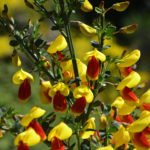



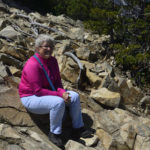






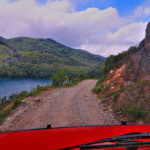







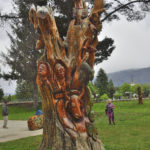
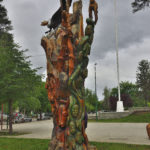



Schreibe den ersten Kommentar